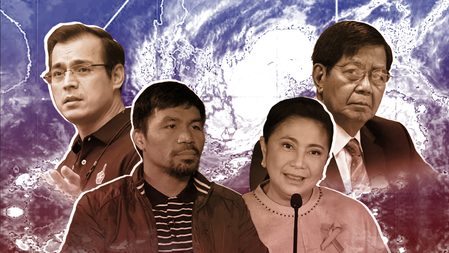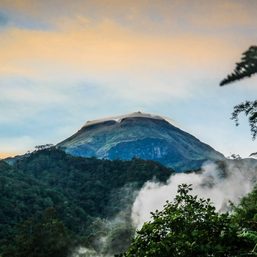SUMMARY
This is AI generated summarization, which may have errors. For context, always refer to the full article.
![[OPINION] Can I save the planet by deleting unwanted emails?](https://www.rappler.com/tachyon/2022/04/tl-email.jpg)
Scientists protested in front of the JP Morgan Chase building in the United States, which is one of the biggest financing firms supporting the fossil fuel industry. Among the scientists is Dr. Peter Kalmus of the National Aeronautics and Space Administration (NASA) whose video became viral, even in the Philippines.
“We’re going to lose everything, we’re not lying, we’re not exaggerating,” Dr. Kalmus spoke to the protesters in Los Angeles.
Dr. Kalmus’ plea reverberated in social media and has gone beyond echo chambers. His words and the protesters’ display of courage pushed a renewed call for Filipinos to also take climate actions. This resulted in a wave of people, even those who knew little or were indifferent about climate change before, to give the crisis the long-overdue attention it deserves.
Posts calling for Filipinos to take individual climate actions spread on Facebook like wildfire. Everyone is asked to adjust their lifestyle by saving electricity, switching to LED lights, and even deleting unwanted emails to reduce carbon emission. However, these calls for action online did not completely echo what the scientist protest stood for.
An unintentional smokescreen covering the truth
Reducing personal carbon footprint is indeed a step in the right direction and everyone must strive to help mitigate the crisis through individual actions. However, the renewed calls for individual actions cast a blanket of smoke that unintentionally covers the truth about what we need to achieve collectively as a global society.
It is crucial to remember that keeping unwanted emails and continuing unsustainable actions are not the only reasons why we are in this ugly situation. Focusing on individual actions inadvertently sways the focus away from the real culprit behind climate change. Pushing only for individual actions as the way to solve the crisis deviates from what Dr. Kalmus and other scientists have been telling the world for decades.
In the protest, the scientist asked everyone to stand-up, take risks, and make sacrifices for the planet. But most importantly, he also underscored that the world must “stop this fossil fuel history” and “financing fossil fuels.”
The climate crisis, and the risks that come with it, is due to the reliance on fossil fuels such as oil, coal, and gas. However, big industries and most governments ignored the science and continued to exploit Earth’s natural resources by extracting and using fossil fuels.
For instance, according to the data compiled by World Resources Institute, the biggest carbon-emitting industry is the energy sector which produces 76% of the global carbon dioxide emissions worldwide. The energy sector is largely powered by fossil fuels.
The Philippines is notably one of the least contributors to the climate crisis. According to the World Bank, an average Filipino produced an estimated 1.33 metric tons of carbon dioxide emissions in 2018. The emissions come from Filipinos’ individual actions, including the use of technology and food and electric consumption. One metric ton sounds a lot. However, that amount is dwarfed by the emissions of developed nations. For example, the average carbon dioxide emission of a person living in the United States in 2018 is at 15.24 metric tons!
Countries with the least carbon emissions are suffering the most
While developing nations such as the Philippines contribute a very small fraction of carbon emissions, yet they suffer most of the crisis’ severe consequences. Just recently, the Philippines was hit by tropical storm Agaton which devastated parts of Visayas and Mindanao and impacted thousands of lives. Aside from extreme weather events, the country is also affected by slow-onset events. For instance, the archipelago’s coasts are extremely vulnerable to sea level rise.
According to Greenpeace East Asia, approximately 37.29 square kilometers of land in Metro Manila alone can be flooded by sea level rise by 2030 if we do not address climate change now. Landmarks of the capital, such as the Malancañan Palace, Luneta, and Intramuros can be inundated by flood. An estimated 1.54 million Filipinos can be impacted by the rising sea level in Metro Manila. The New York Times aptly referred to this phenomenon as “rising water, sinking city.”
Going beyond the first few steps
Individual actions are the first steps to combating climate change. However, it’s just the beginning and Filipinos shouldn’t stop there. Individual climate actions are a must and they are also the most tangible steps everyone can do on a day-to-day basis. But alongside these actions, a systemic change must take place. This means that the world, and societies, must also change.
Calling for action and spreading awareness about climate change must include measures aimed at redesigning the system in order for humanity to #LetTheEarthBreathe. Pushing systemic changes is not as overwhelming as it sounds, especially if these actions can be linked to everyone’s individual choices and needs. Here are some of the steps Filipinos can take to drive systemic changes.
Vote for leaders in the government who would put the people and the environment first. This coming elections, choose leaders who will protect the people and the environment and who would transition the Philippines towards a greener future by divesting from fossil fuels and pushing for renewable energy.
Urge the government to protect your immediate environment. Sign petitions to protect natural resources! Send letters or emails to local leaders and congressmen and let them know that their constituents care about the environment. A healthy and fully-functioning environment is needed, both in sea and on land, to mitigate, and adapt to, climate change.
Support businesses caring for the environment. Support companies, especially small businesses, balancing financial needs and environmental protection. Choose products that have the least possible environmental impact. Let them know that you got their backs to encourage other businesses to do the same.
These are just some of the steps that drive systemic change. Don’t forget the real issue. The renewed call for climate action unintentionally made it appear that individual choices are the only reason why the world is suffering from climate change. It is not the case. – Rappler.com
Harvey Perello is an environmentalist advocating for healthy oceans and climate change mitigation. He’s also a project manager at Save Philippine Seas, and a climate reality leader of the Climate Reality Project. He is studying environmental science and is an oceanography researcher at Oregon State University.
Add a comment
How does this make you feel?

![[OPINION] Resilience in a riskier world](https://www.rappler.com/tachyon/2020/11/Disaster-Resilience-November-13-2020.jpg?fit=449%2C449)
![[OPINION] Choose leaders who understand climate change](https://www.rappler.com/tachyon/2021/10/choose-leaders-climate-change-october-20-2021-sq-1.jpg?fit=449%2C449)





There are no comments yet. Add your comment to start the conversation.